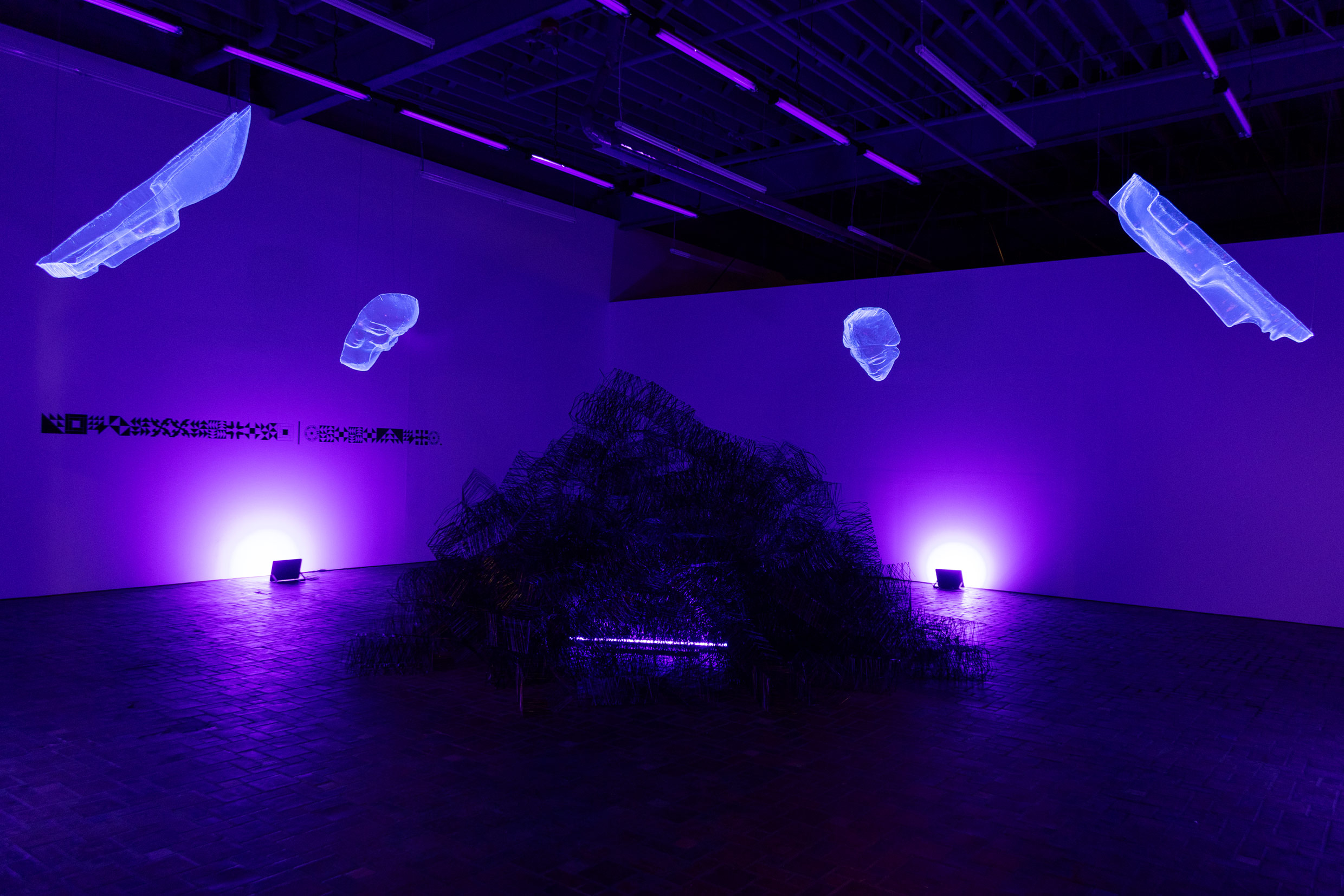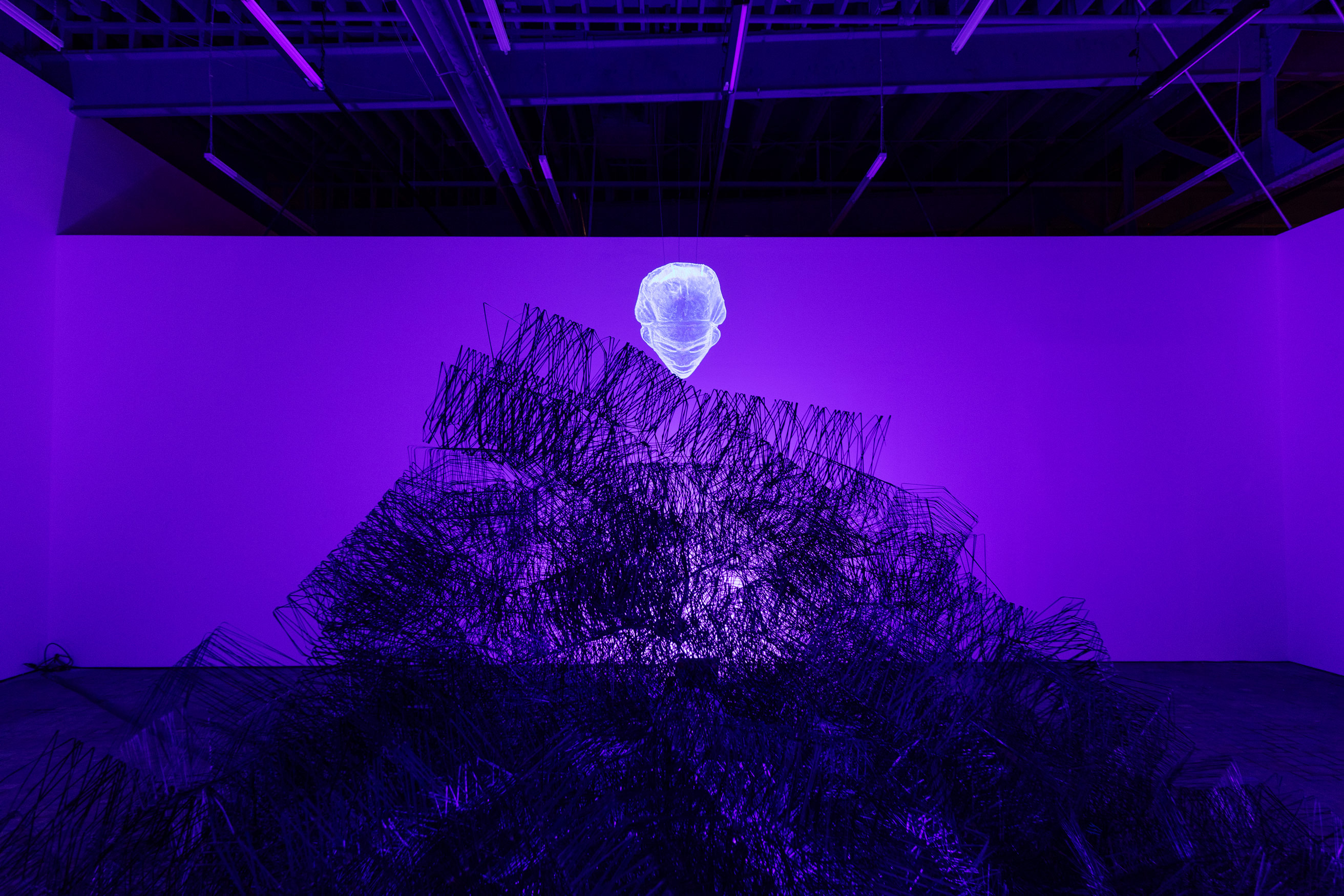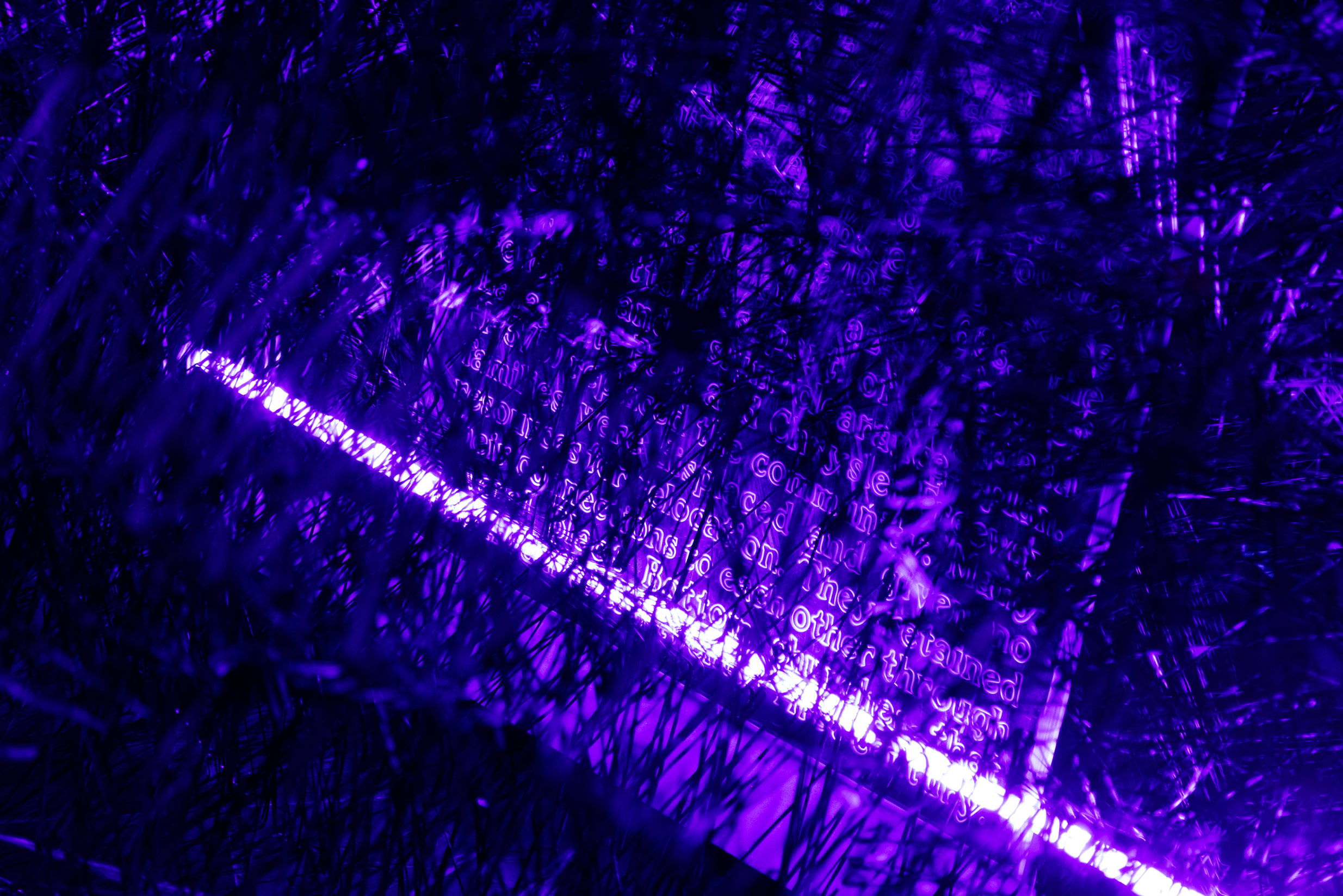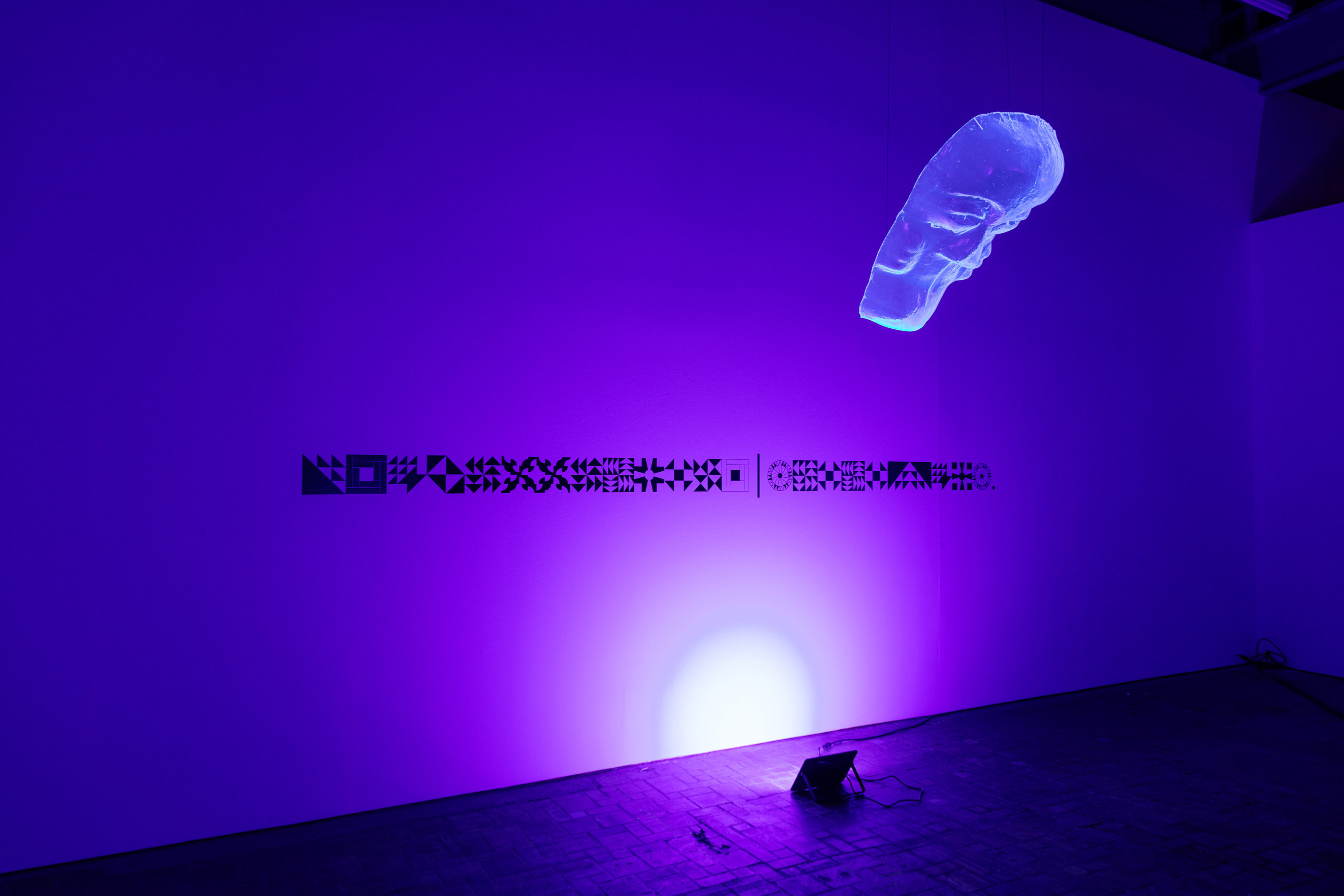
Ashley Cook
December 18, 2023

Kevin Bernard Moultrie Daye, also known as SPIRITUALS, is a Detroit-based architectural designer, artist, curator, music producer and performer. He was born on the East Coast, raised on the West Coast and currently teaches architecture at the University of Michigan in Ann Arbor. His exhibition shadowworking on view at The Museum of Contemporary Art Detroit applies methods from his various creative backgrounds to deliver an encompassing experience that can satisfy both a passive and active viewership.

A handful of elements come together to entice a curiosity that could only occur by presenting coded messages in such a beautiful way. The artwork is lit in a purple hue that activates the visibility of the four mask-like sculptures floating centered at each wall. These sculptures have an aesthetic quality that recalls the glow of 1980s neon and the weightlessness of Y2K internet visuals. Centered in the room is a mound of die-cut paper forms that, from afar, looks like a large nest illuminated from within. On one of the walls is a series of glyphs that corresponds with a story and a code key included in the exhibition text. Each of these details inform the others to create a space that feels sacred. The artist’s experience studying philosophy at University of California, Los Angeles, and architecture at University of California, Berkeley exposed him to the Light and Space movement that originated in 1960s Southern California. KBMD considers his exhibition at MOCAD to be an extension of this movement as he explores mysticism and considers its occupation within a contemporary art context.
The Light and Space movement is known for its careful use of form, color, and light to create harmonious settings that evoke a sense of calm. Artists working within this realm of thought often build site-specific installations that take almost everything into account including the architecture, the natural environment and even sometimes the socio-cultural context surrounding the location where the work would be shown. With each of these aspects being essential, the work is only complete when all of them are present. There are usually no lessons, stories or theories to take in. Visitors of such an installation are required to do nothing more than sit and appreciate the serenity brought about by an individual who has a particularly sensitive eye for detail. While shadowworking sets up an environment that visually embodies this philosophy, it breaks from it in order to reflect on its capabilities and critique its limitations. KBMD uses its ethereal vibes and its fundamental place within the history of art as a frame within which to touch on spirituality in Black culture and the importance of exclusivity as a mechanism for its preservation.
KBMD: The whole genesis of this project started with a short story by Henry Dumas called “Will the Circle Remain Unbroken?” It is a story about this guy who is a Coltrane-like figure who goes to Africa and comes back with the instrument called the Afro-Harp that causes him to create the most incredible jazz music. The story goes that he returns back home and three of his friends who were white wanted to come and see him play one evening at the club, but the place would not let them in, saying it was just for brothers and sisters. The white folks got upset and called on a police officer nearby who ordered that they let them in and stop discriminating, so they are finally let in. The musician goes on stage, blows through the Afro-Harp and as soon as the first note leaves the instrument, all of the hearts of the white people stop beating.
The reason why I am so inspired by this story is because it is saying “not everything is for everyone”. Its not about being bad or good or unwelcome necessarily, but its just that some places are sacred and reserved for only certain people and that needs to be honored. Since the first moment where Africans were taken from Africa both by their own people and by enslavers, it has been really rare and difficult to find spaces where there aren’t white eyes. Even after forcing all of these people to adopt Christianity, they needed to make a way that they could be sure that the Bible would make them servile. While the Black community would be at church, there always needed to be a white person present.
I remember the first time I watched Paris is Burning and thinking hat Jennie Livingston was probably one of the first people to film the ballroom community and present it to a broader audience. I wondered how her presence and the presence if the camera consciously or subconsciously affected the authenticity or freedom of their performances. There is just something really powerful about being un-watched.1

The exploitation that Black people have endured throughout time, and the secrecy that this has fostered within their communities, is a focus of the show. KBMD expressed an interest in a new way of story telling within an art exhibition context...
KBMD: Oftentimes when people tell their stories, especially those whose stories have been buried or obscured, they do it in this super didactic way. Here, I am interested in exploring a space that exists in-between the non-specific and didactic.2
While taking in the ambiance, there is an opportunity to learn about the Underground Railroad Quilt Codes and the Detroit neighborhood called Black Bottom. The authentic African masks that were 3D scanned and re-created by hand function like protective ancestors. They watch over the artifacts that remind us of these stories while also highlighting their ongoing presence as spiritual objects that represent an ancient and persisting lineage. The name of the exhibition is shadowworking, which is a term used within the context of mental health to describe an intentional recognition and acceptance of our repressed darkness and shame. It is understood that working with the shadow is the only way to truly address our trauma.
KBMD: I think a lot about the concept of the shadow, things that are hidden, not seen or acknowledged. In this show, the shadow is present both literally and figuratively. In addition to the masks, illuminated with the UV lighting, the piled up silhouettes are shaped like old-style family homes from Black Bottom in Detroit, a predominantly Black neighborhood that was demolished in the late 1950s in order to build the I-375 freeway and Lafayette Park. Like the quilt codes, these homes now only exist in memory as a representation of the dark history of the US. I believe that by unearthing these artifacts and stories, we can participate in shadow work on a national level, and from there, begin to heal.3

shadowworking at The Museum of Contemporary Art Detroit opened on September 29, 2023 and featured musical performances by Kevin Bernard Moultrie Daye as SPIRITUALS, Zeloopers, HiTech and special guest Hamzat Raheem. The exhibition is temporary closed, but will reopen at MOCAD on January 18, 2024 and remain open until February 4th, 2024. https://mocadetroit.org/shadowworking
*Images courtesy of Clare Gatto and The Museum of Contemporary Art
1. Kevin Bernard Moultrie Daye in discussion with Ashley Cook, September 2023.
2. ibid
3. ibid